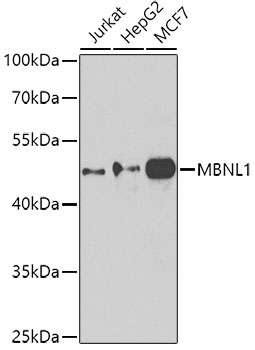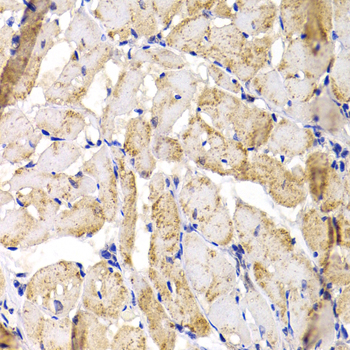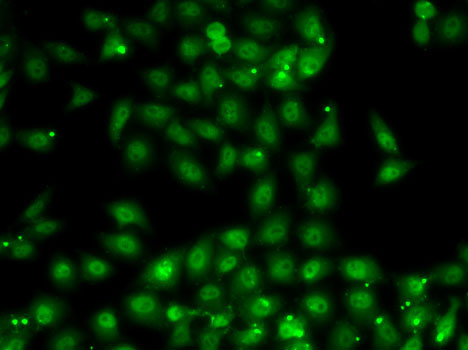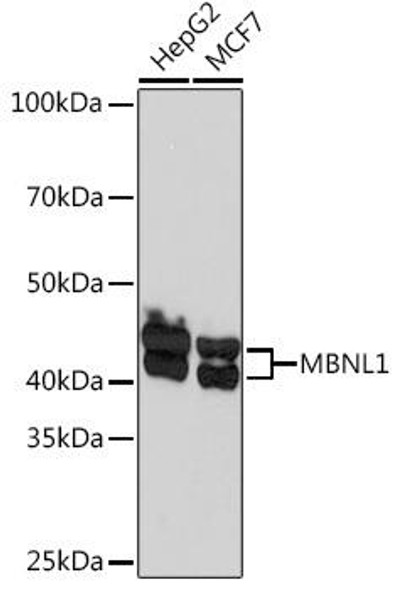Epigenetics & Nuclear Signaling Antibodies 4
Anti-MBNL1 Antibody (CAB8054)
- SKU:
- CAB8054
- Product Type:
- Antibody
- Applications:
- WB
- Applications:
- IHC
- Applications:
- IF
- Reactivity:
- Human
- Reactivity:
- Mouse
- Reactivity:
- Rat
- Host Species:
- Rabbit
- Isotype:
- IgG
- Research Area:
- Epigenetics and Nuclear Signaling
Description
| Antibody Name: | MBNL1 Rabbit Polyclonal Antibody |
| Antibody SKU: | CAB8054 |
| Antibody Size: | 20uL, 50uL, 100uL |
| Application: | WB IHC IF |
| Reactivity: | Human, Mouse, Rat |
| Host Species: | Rabbit |
| Immunogen: | Recombinant fusion protein containing a sequence corresponding to amino acids 1-382 of human MBNL1 (NP_066368.2). |
| Application: | WB IHC IF |
| Recommended Dilution: | WB 1:500 - 1:2000 IHC 1:50 - 1:200 IF 1:50 - 1:100 |
| Reactivity: | Human, Mouse, Rat |
| Positive Samples: | Jurkat, HepG2, MCF7 |
| Immunogen: | Recombinant fusion protein containing a sequence corresponding to amino acids 1-382 of human MBNL1 (NP_066368.2). |
| Purification Method: | Affinity purification |
| Storage Buffer: | Store at -20'C. Avoid freeze / thaw cycles. Buffer: PBS with 0.02% sodium azide, 50% glycerol, pH7.3. |
| Isotype: | IgG |
| Sequence: | MAVS VTPI RDTK WLTL EVCR EFQR GTCS RPDT ECKF AHPS KSCQ VENG RVIA CFDS LKGR CSRE NCKY LHPP PHLK TQLE INGR NNLI QQKN MAML AQQM QLAN AMMP GAPL QPVP MFSV APSL ATNA SAAA FNPY LGPV SPSL VPAE ILPT APML VTGN PGVP VPAA AAAA AQKL MRTD RLEV CREY QRGN CNRG ENDC RFAH PADS TMID TNDN TVTV CMDY IKGR CSRE KCKY FHPP AHLQ AKIK AAQY QVNQ AAAA QAAA TAAA MGIP QAVL PPLP KRPA LEKT NGAT AVFN TGIF QYQQ ALAN MQLQ QHTA FLPP GSIL CMTP ATSV VPMV HGAT PATV SAAT TSAT SVPF AATA TANQ IPII SAEH LTSH KYVT QM |
| Gene ID: | 4154 |
| Uniprot: | Q9NR56 |
| Cellular Location: | Cytoplasm, Cytoplasmic granule, Nucleus |
| Calculated MW: | 33kDa/34kDa/36kDa/37kDa/39kDa/40kDa/41kDa |
| Observed MW: | 42kDa |
| Synonyms: | MBNL1, EXP, MBNL |
| Background: | This gene encodes a member of the muscleblind protein family which was initially described in Drosophila melanogaster. The encoded protein is a C3H-type zinc finger protein that modulates alternative splicing of pre-mRNAs. Muscleblind proteins bind specifically to expanded dsCUG RNA but not to normal size CUG repeats and may thereby play a role in the pathophysiology of myotonic dystrophy. Mice lacking this gene exhibited muscle abnormalities and cataracts. Several alternatively spliced transcript variants have been described but the full-length natures of only some have been determined. The different isoforms are thought to have different binding specificities and/or splicing activities. |
| UniProt Protein Function: | MBNL1: Mediates pre-mRNA alternative splicing regulation. Acts either as activator or repressor of splicing on specific pre-mRNA targets. Inhibits cardiac troponin-T (TNNT2) pre-mRNA exon inclusion but induces insulin receptor (IR) pre-mRNA exon inclusion in muscle. Antagonizes the alternative splicing activity pattern of CELF proteins. Regulates the TNNT2 exon 5 skipping through competition with U2AF2. Inhibits the formation of the spliceosome A complex on intron 4 of TNNT2 pre-mRNA. Binds to the stem-loop structure within the polypyrimidine tract of TNNT2 intron 4 during spliceosome assembly. Binds to the 5'-YGCU(U/G)Y- 3'consensus sequence. Binds to the IR RNA. Binds to expanded CUG repeat RNA, which folds into a hairpin structure containing GC base pairs and bulged, unpaired U residues. Plays a role in the pathogenesis of dystrophia myotonica type 1 (DM1). A muscular disorder characterized by myotonia, muscle wasting in the distal extremities, cataract, hypogonadism, defective endocrine functions, male baldness and cardiac arrhythmias. In muscle cells from DM1 patients, MBNL1 is sequestered by DMPK RNAs containing CUG triplet repeat expansions. MBNL1 binding is proportional to repeat length consistent with the direct correlation between the length of repeat expansion and disease severity. Belongs to the muscleblind family. 6 isoforms of the human protein are produced by alternative splicing. |
| UniProt Protein Details: | Protein type:RNA splicing; RNA-binding Chromosomal Location of Human Ortholog: 3q25 Cellular Component: centrosome; cytoplasm; nucleoplasm; nucleus; stress granule Molecular Function:double-stranded RNA binding; metal ion binding; protein binding; RNA binding Biological Process: embryonic limb morphogenesis; in utero embryonic development; mRNA splice site selection; myoblast differentiation; nervous system development; regulation of alternative nuclear mRNA splicing, via spliceosome; regulation of RNA splicing; RNA splicing; skeletal muscle development |
| NCBI Summary: | This gene encodes a member of the muscleblind protein family which was initially described in Drosophila melanogaster. The encoded protein is a C3H-type zinc finger protein that modulates alternative splicing of pre-mRNAs. Muscleblind proteins bind specifically to expanded dsCUG RNA but not to normal size CUG repeats and may thereby play a role in the pathophysiology of myotonic dystrophy. Mice lacking this gene exhibited muscle abnormalities and cataracts. Several alternatively spliced transcript variants have been described but the full-length natures of only some have been determined. The different isoforms are thought to have different binding specificities and/or splicing activities. [provided by RefSeq, Sep 2015] |
| UniProt Code: | Q9NR56 |
| NCBI GenInfo Identifier: | 930945856 |
| NCBI Gene ID: | 4154 |
| NCBI Accession: | NP_001300986.1 |
| UniProt Secondary Accession: | Q9NR56,O43311, O43797, Q86UV8, Q86UV9, Q96P92, Q96RE3 E9PBW7, |
| UniProt Related Accession: | Q9NR56 |
| Molecular Weight: | 57 kDa |
| NCBI Full Name: | muscleblind-like protein 1 isoform h |
| NCBI Synonym Full Names: | muscleblind like splicing regulator 1 |
| NCBI Official Symbol: | MBNL1 |
| NCBI Official Synonym Symbols: | EXP; MBNL |
| NCBI Protein Information: | muscleblind-like protein 1 |
| UniProt Protein Name: | Muscleblind-like protein 1 |
| UniProt Synonym Protein Names: | Triplet-expansion RNA-binding protein |
| Protein Family: | Muscleblind-like protein |
| UniProt Gene Name: | MBNL1 |
| UniProt Entry Name: | MBNL1_HUMAN |
View AllClose









